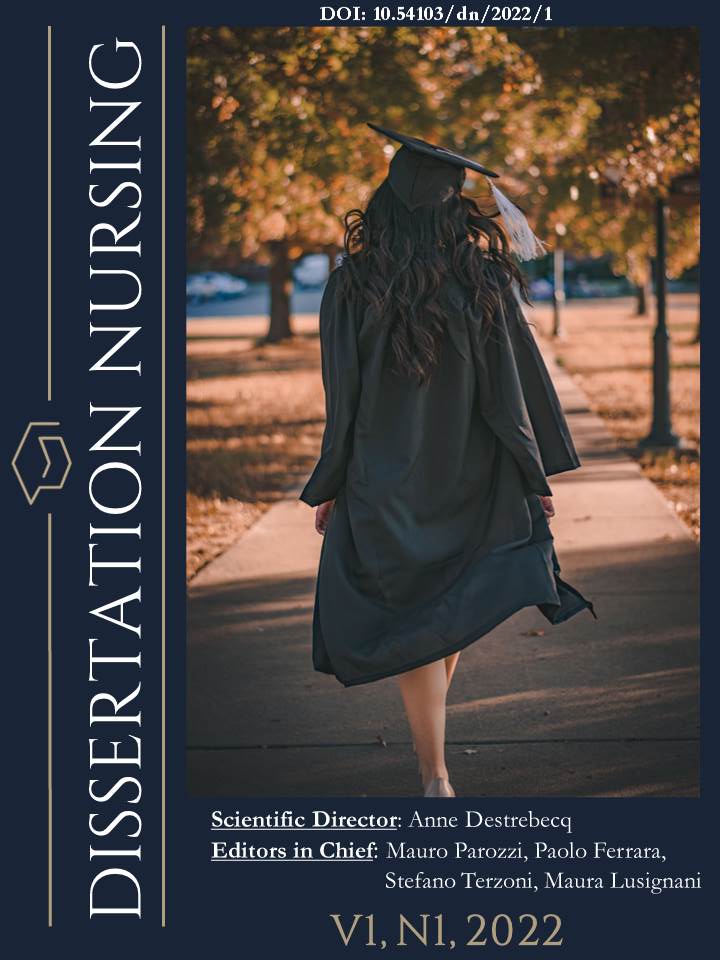Validation of the Italian version of the White Fast-track Scoring Criteria: a prospective, observational study
DOI:
https://doi.org/10.54103/dn/18293Keywords:
Perioperative care, White Fast-Track, Surgical procedure, Nursing, PreventionAbstract
BACKGROUND:
patients undergoing surgery are subject to adverse events, in the hours immediately after discharge from the operating theatre. The White Fast-Track scoring criteria scale is suitable for early detection of the risk of postoperative complications, but it has not been validated into Italian. Moreover, it should be completed with additional parameters, to allow complete postoperative surveillance.
AIM:
this study is aimed to translate and validate into Italian the White fast-track scoring criteria and to produce a modified version, to obtain a more complete assessment of major surgery operations.
METHODS:
Quantitative, observational, prospective, monocentric study, on a non-randomized sample of patients aged 18 or more, undergoing general, thoracic, vascular, urological, orthopedic, gynecological, endocrinological, breast, nose-throat, or facial surgery, in the recovery room of a teaching hospital in Milan.
RESULTS:
250 patients were enrolled. The original scale showed good inter-rater reliability, internal consistency, and test-retest reliability. The same applied to the modified version. The original scale allowed identifying 18 patients at risk; the modified version identified 20, who could have been discharged according to the original criteria, who actually developed postoperative complications.
DISCUSSION:
The Italian White fast-track scoring criteria is a valid tool, and it can be used by nurses to perform appropriate postoperative surveillance, as well as to prevent early postoperative complications.
CONCLUSIONS:
The modified version reflects the real surveillance performed in a recovery room, and shows satisfactory reliability, sensitivity, and specific if compared to the original tool.
References
Leykin Y, Costa N, Gullo A. [Analysis and comparison of the guidelines regarding recovery-room management]. Minerva Anestesiol. 2001;67(7–8):563–71.
Yamasaki H, Tanaka K, Funai Y, Suehiro K, Ikenaga K, Mori T, et al. The impact of intraoperative hypothermia on early postoperative adverse events after radical esophagectomy for cancer: a retrospective cohort study. J Cardiothorac Vasc Anesth. 2014 Aug;28(4):943–7.
Lenhardt R. Monitoring and thermal management. Best Pract Res Clin Anaesthesiol [Internet]. 2003;17(4):569–81. Available from: https://www.sciencedirect.com/science/article/pii/S152168960300048X
Celotto S, Nesci M, Lucchini A, Bellani S, Bombino M. [Vital signs of hemodynamic monitoring]. Minerva Anestesiol. 2003 Apr;69(4):289–96.
McAlister FA, Bertsch K, Man J, Bradley J, Jacka M. Incidence of and Risk Factors for Pulmonary Complications after Nonthoracic Surgery. Am J Respir Crit Care Med [Internet]. 2005 Mar 1;171(5):514–7. Available from: https://doi.org/10.1164/rccm.200408-1069OC
Burke B, Kyker M. Speeds Criteria vs. Modified Aldrete and Fast-Track Criteria for Evaluating Recovery in Outpatients. Open J Anesthesiol. 2013;03(07):309–14.
Neveleff DJ, Kraiss LW, Schulman CS. Implementing Methods to Improve Perioperative Hemostasis in the Surgical and Trauma Settings. AORN J [Internet]. 2010 Nov 1;92(5):S1–15. Available from: https://doi.org/10.1016/j.aorn.2010.08.006
Lau H, Lam B. Management of postoperative urinary retention: a randomized trial of in−out versus overnight catheterization. ANZ J Surg [Internet]. 2004 Aug 1;74(8):658–61. Available from: https://doi.org/10.1111/j.1445-1433.2004.03116.x
Keita H, Diouf E, Tubach F, Brouwer T, Dahmani S, Mantz J, et al. Predictive factors of early postoperative urinary retention in the postanesthesia care unit. Anesth Analg. 2005 Aug;101(2):592–6.
Practice guidelines for acute pain management in the perioperative setting: an updated report by the American Society of Anesthesiologists Task Force on Acute Pain Management. Anesthesiology. 2012 Feb;116(2):248–73.
Gan TJ, Meyer TA, Apfel CC, Chung F, Davis PJ, Habib AS, et al. Society for Ambulatory Anesthesia guidelines for the management of postoperative nausea and vomiting. Anesth Analg. 2007 Dec;105(6):1615–28, table of contents.
McCracken G, Houston P, Lefebvre G. Guideline for the Management of Postoperative Nausea and Vomiting. J Obstet Gynaecol Canada [Internet]. 2008;30(7):600–7. Available from: http://dx.doi.org/10.1016/S1701-2163(16)32895-X
Fernández-Guisasola J, Gómez-Arnau JI, Cabrera Y, del Valle SG. Association between nitrous oxide and the incidence of postoperative nausea and vomiting in adults: a systematic review and meta-analysis. Anaesthesia [Internet]. 2010 Apr 1;65(4):379–87. Available from: https://doi.org/10.1111/j.1365-2044.2010.06249.x
White PF, Song D. New criteria for fast-tracking after outpatient anesthesia: a comparison with the modified Aldrete’s scoring system. Anesth Analg. 1999 May;88(5):1069–72.
Aldrete JA, Kroulik D. A postanesthetic recovery score. Anesth Analg. 1970;49(6):924–34.
Polit DF, Beck CT. The content validity index: Are you sure you know what’s being reported? critique and recommendations. Res Nurs Health [Internet]. 2006 Oct 1;29(5):489–97. Available from: https://doi.org/10.1002/nur.20147
Barretto de Carvalho Fernandes M do C, Vieira da Costa V, Saraiva RA. Postoperative urinary retention: evaluation of patients using opioids analgesic. Rev Lat Am Enfermagem. 2007;15(2):318–22.
Verhamme KMC, Dieleman JP, Van Wijk MAM, van der Lei J, Bosch JLHR, Stricker BHC, et al. Nonsteroidal anti-inflammatory drugs and increased risk of acute urinary retention. Arch Intern Med. 2005 Jul;165(13):1547–51.
Australian and New Zealand College of Anaesthetists & the Faculty of Pain Medicine. PS04(A) Position statement on the post-anaesthesia care unit. 2020;04:1–9. Available from: https://www.anzca.edu.au/getattachment/7045495a-0f12-4464-852c-b93c0453e1ed/PS04(A)-Position-statement-on-the-post-anaesthesia-care-unit-(PS04)#page=
Ead H. From Aldrete to PADSS: Reviewing discharge criteria after ambulatory surgery. J perianesthesia Nurs Off J Am Soc PeriAnesthesia Nurses. 2006 Aug;21(4):259–67.
Downloads
Published
How to Cite
Issue
Section
License
Copyright (c) 2022 Paola Casati, Claudia Sansone

This work is licensed under a Creative Commons Attribution-NonCommercial-NoDerivatives 4.0 International License.
Accepted 2022-07-25
Published 2022-07-29











